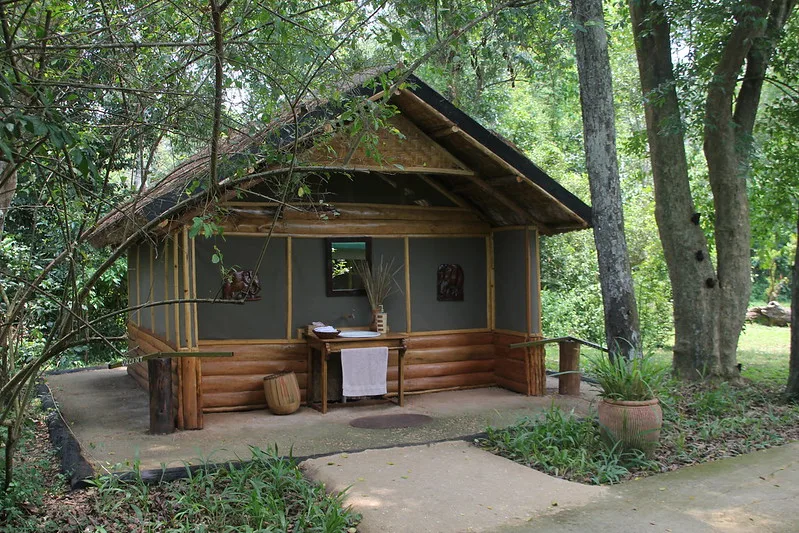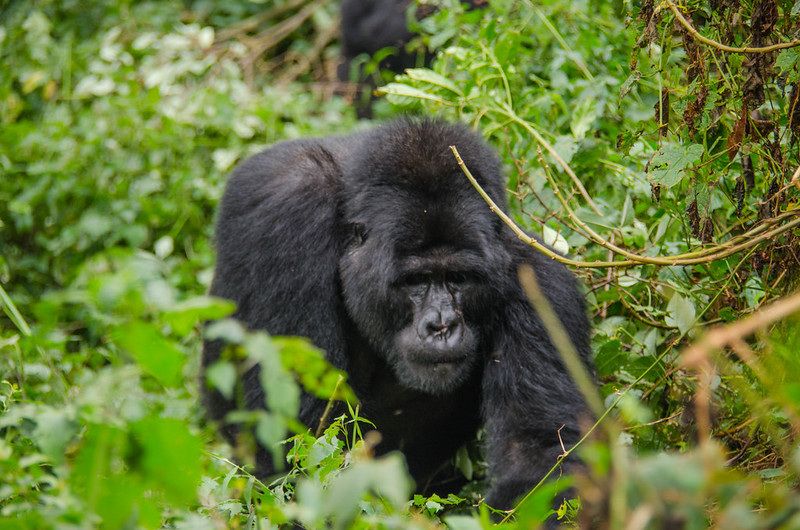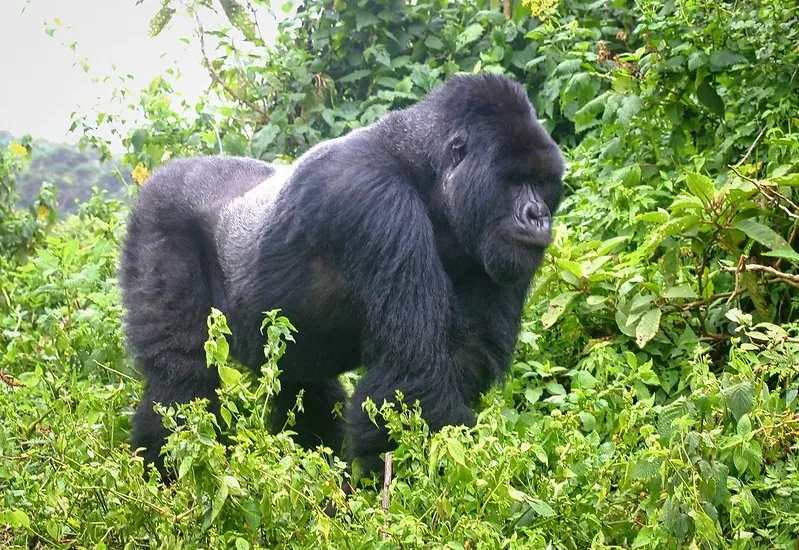Vous êtes bienvenus, aventuriers courageux, dans les merveilles sauvages de l'Ouganda, où l'appel de la…
Mountain Gorillas live in Bwindi Impenetrable National Park.
Bwindi Impenetrable National Park was established in 1991 and was designated a UNESCO Natural World Heritage Site in 1994. It is one of the rare areas on the planet where animals (both wild and domesticated), hills, rivers, waterfalls, woods, and humans coexist brilliantly. The park is located among the dimly lit Bwindi Impenetrable Forest, one of Uganda’s most diverse and dignified rainforests, which shadows the mist-covered hillsides at an elevation of 1,160m-2,607m above sea level.
It balances on the spine between southern Uganda and the Democratic Republic of the Congo, near the Virunga National Park, on the verge of the Albertine rift. The area has become one of the world’s biggest adrenaline capitals, and it is known as a place defined not only by physical location but also by memories that only you and those who share your experiences can access.
The park’s landscape consists of a succession of mountain ranges and valleys over which grows a thick and deep network of forest cover, giving rise to the park’s nickname “impenetrable.” Throughout the day, the horizon within the park portrays a hazy environment that practically hampers sight to regulated distances. As a result, the forest floors enjoy a consistent chilly climate throughout the year, thanks to the heavy undergrowth of broad-leaved herbaceous plants. Bwindi is a succession of high peaks and valleys that serve as the source of five major rivers that pour into Lake Edward.
There are also streams of pure water that constantly slither down from the various falls, as well as almost 400 plant species that have patiently withstood the tremendous storms that rage across the forest during the severe rains. The rhythmic churn of the cascading waters of the waterfalls is so lovely that one cannot but enjoy the magnificent flow of this rather unreal form of perfection. Could this be the final reason why it’s known as the country’s Switzerland?
Bwindi is 321 square kilometers in size and is made up of both montane and lowland forests densely forested with bamboo and bushes. These woodlands are approximately 25,000 years old and home to around 400 plant species. Bwindi might be a sanctuary for botanists due to the abundance of plant species that outnumber the variety of the forest. The forest also has a plethora of bird species that know everything there is to know about composing some of the sweetest melodies any human ear could ever treat itself to, leaving one with the perplexingly juxtaposed options of trying hard to whistle along or simply sitting back and simply blushing in awe!!
The forest is home to over 350 species of birds, including hornbills and turacos, as well as 23 Albertine Rift endemics. The Africa Bird Club ranked the park Africa’s top birding destination. A birder should be able to stamp his or her feet in anticipation of identifying and appreciating the park’s species richness in terms of the bird variety.
The naturally varied territory also shelters 120 animals that are rarely seen because they hide in the thickets, 27 kinds of frogs, chameleons, geckos, and many endangered species, including baboons and chimps, as well as elephants and antelopes. Aside from plant and animal species, the forest offers the opportunity to experience the beauty of color as several kinds of butterflies discreetly sing love songs about the beautiful roses that bloom beneath the cypresses. Within the forest, it is believed that there are 220 different species of butterflies.
A visit to the park provides the ultimate gorilla experience, as the park is home to the world’s endemic mountain gorillas. There are 459 mountain gorillas who call this particular habitat home. Mountain gorillas are a fascinating species to work with. They are defined by their social livelihood. Hierarchy, like any other human household structure, is critical in developing this tie of solidarity. The “silverback” is the dominant man in any household and must thus be treated with respect commensurate with his social standing. What a fantastic idea! You must have firsthand knowledge of this.
The most visible activity in this park is gorilla tracking. During this excursion, tourists are escorted on a guided trip across the park on foot, beneath the cool forest cover, rising and descending the park’s hills and valleys. One may get up close and personal with the world’s mountain gorillas, who are only found in this location! In Bwindi Impenetrable National Park, gorilla tracking takes place at four different places. Buhoma, Ruhija, Rushaga, and Nkuringo are among them. As of December 2019, these four areas have a total of twenty-one habituated gorilla families.
Bwindi Impenetrable National Park Activities
Aside from gorilla trekking, there are a variety of additional activities that may be added to your safari to make it more memorable. Gorilla tracking, bird watching, nature and waterfall walks, mountain hiking, mountain biking, community walks, and cultural encounters are examples of such activities. Canoeing is also available at several crater lakes, such as Mutanda.
However, the presence of several routes that beautify the forest facilitates the majority of these activities. Buhoma, Ruhija, Rushaga, and Nkuringo all have trails. Some are birding walks, while others concentrate on the scenery of the Bwindi Impenetrable Forest. The hiking experience is more unforgettable, whether it is a one-day journey through Bwindi Impenetrable Forest or a multi-day trek from the northern end of Bwindi to the southern point known as Nkuringo.
Bwindi Impenetrable National Park nature trailheads and treks
Trailheads have a mystique about them that makes every moment fascinating because of a gratifying experience that is tinted with a lot of learning and delight. With each step into the forest, the yearning to see more grows within the four-chambered heart, as more buried truths begin to emerge one by one. Many of these amazing walkways have been created in Buhoma. These are some examples:![]()
Buhoma community walk: This exposes the locals that live near the Bwindi Impenetrable National Park as well as their culture. During this stroll, one learns about cultural practices, has access to locally manufactured art crafts, and has the option to observe spectacular dance performances that are embellished with a lot of art. It is during such a task that the ancient methods of cooking, brewing, and applying local remedies become plain and vivid to every explorer who has fun on their to-do list. The Buhoma Village Walk allows visitors to watch residents, tour a typical farmhouse, and learn about Batwa culture. The trek lasts around three hours.
Munyaga River Trail: This is one of the simplest foot pathways in the forest, taking around 2 hours to walk from the end of Buhoma Road across Bizinge Creek to the bank of the Munyaga River. The route is designed in such a manner that one does not have to turn back but gradually returns to the starting location as the adventure progresses. During the walk, every participant has the option to stop beside the River Munyaga, allowing them to observe ladies washing their clothing by hand, rather than using machines. A spectacular glimpse of many wonderfully colored butterflies is unavoidable along the cliffs.
River Munyaga is also a popular destination for birding expeditions, and it is home to a variety of species, some of which are peculiar to the forest. The route is located in the Buhoma Valley and is a short stroll that allows you to observe primates on the fringes of the forest.
Muzabajiro loop trail: This is a good trek that takes tourists through the Muzabijiro stream before rising through the canopy forest to Ruhubra hill. The national park’s abundant vines and slick boles of dead trees provide beautiful views.
Waterfall path: A waterfall in the center of the farmland may have inspired the creation of the waterfall trail. This walk is around three hours long and goes beneath tree ferns, epiphytic ferns, and orchids. It takes a lot of climbs to reach the top waterfalls since one must bypass two waterfalls before being rewarded with the joy of reaching the last one. A variety of tea is grown on the hillsides, adding to the scenic atmosphere.
Rushura hill trail: This is the most demanding climb in the forest, lasting around 3 hours to the highest point of Rushura hill, which is located at an elevation above sea level. This route leads through the forest to the mountain’s summit, where travelers may see the western rift valley, Lake Edward, the unique Rwenzori Mountains, and the Virunga mountains.
Bamboo trail: This trail is located at the highest point of Rwamunyo forest, at an elevation of 2,607m/8,550ft above sea level. It takes around 6 hours to get to the final point. The bamboo provides the opportunity to wander among many types of flora, which is noteworthy. The many plant types include bamboo forest, alpine vegetation, and afro montane vegetation at the highest altitude.
River Ivi path: This trail links to the national park’s southern part and is mostly used by locals to get to local gardens and markets. The trek takes around 6 hours and follows an ancient road through the bush, arriving near Nkuringo on the southern edge of the impenetrable forest. Tourists are encouraged to witness a variety of wildlife, including local people, monkeys, bush pigs, birds, and mountain gorillas, among others while hiking this path. Depending on where you live, you can begin this trek in either in Nkuringo or Buhoma.
Bwindi Impenetrable National Park offers cultural tours and experiences.
A trip to Bwindi is never complete without a stop at the Batwa village. There is much to be learned from these little groups of individuals who spend their daily lives in the middle of the forest. There is undoubtedly much to learn about how they have become acclimated to their way of life. One can meet local herbalists who are making sustainable use of the forest’s flora richness. This is also one of the tribes assumed to have historically emerged from the Bantu ethnic group of migrants. There is a lot of history to be learned from the elders and clans in this village. This is an important component of their rich culture.![]()
In any case, there is a lot more to learn from their feeding patterns, cultural dances, and so on. It’s a culture worth learning about. This group also has a tale to share about their efforts to conserve these mountain gorillas as part of a community conservation campaign. Here is another fascinating opportunity: a 3-hour cultural tour around the village where you will learn about the customs and culture of the people who live in the Buhoma region on the outskirts of Bwindi Forest. The Village Walk is conducted by a pleasant local guide who is informed about local culture and customs.
What to bring on your Bwindi Impenetrable National Park and Gorilla Safari.
while at Bwindi Impenetrable National Park trekkers should dress in long-sleeved shirts and long pants, waterproof hiking boots, sturdy gardening gloves, a rain jacket, a hat, plenty of insect repellent, and a warm sweater. You should also bring plenty of water and a camera with additional batteries.


